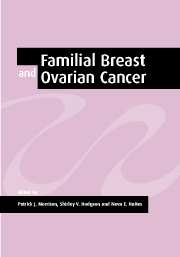Book contents
- Frontmatter
- Contents
- List of contributors
- Foreword by Helena Kennedy
- Preface
- Acknowledgements
- Part 1 Molecular biology and natural history
- Part 2 Screening
- 9 Developing a cancer genetics service: a Welsh model
- 10 Referral criteria for cancer genetics clinics
- 11 Guidelines for the development of cancer genetics services
- 12 Cultural and educational aspects influencing the development of cancer genetics services in different European countries
- 13 Screening, detection and survival patterns of breast and other cancers in high-risk families
- 14 Screening for familial ovarian cancer
- Part 3 Management
- Index
9 - Developing a cancer genetics service: a Welsh model
Published online by Cambridge University Press: 24 August 2009
- Frontmatter
- Contents
- List of contributors
- Foreword by Helena Kennedy
- Preface
- Acknowledgements
- Part 1 Molecular biology and natural history
- Part 2 Screening
- 9 Developing a cancer genetics service: a Welsh model
- 10 Referral criteria for cancer genetics clinics
- 11 Guidelines for the development of cancer genetics services
- 12 Cultural and educational aspects influencing the development of cancer genetics services in different European countries
- 13 Screening, detection and survival patterns of breast and other cancers in high-risk families
- 14 Screening for familial ovarian cancer
- Part 3 Management
- Index
Summary
Although genetic mechanisms have long been recognized as central in the causation of cancer, the practical importance of genetic and familial aspects has only now been widely appreciated. In the past, clinical genetics services were involved only in rare Mendelian cancer genetic disorders in which the risks were clear and intervention or surveillance was possible. It has recently become clear that in some of the more common cancers, notably breast, ovarian and colon cancer, there is a Mendelian subset in which the genetic risks are also extremely high. This subset is considerably more common than the combined incidence of the rarer, single-gene familial cancer syndromes.
The discovery of mutations and specific genes conferring a high risk of colorectal, breast or ovarian cancer means that comparable genetic approaches are now potentially applicable to this subset of common tumours. It is increasingly possible to distinguish family members who carry such genes from those who do not. As a result, surveillance and management resources can be directed towards family members who carry the predisposing gene, and those who do not carry such a gene can avoid the often uncomfortable diagnostic procedures and the possibility of surgical intervention.
A further influence on service demand has been intense media publicity and the high scientific profile of recent discoveries in breast cancer. Concerns are inevitably raised by such stories, and not just in families in which the genetic risk is high.
- Type
- Chapter
- Information
- Familial Breast and Ovarian CancerGenetics, Screening and Management, pp. 143 - 156Publisher: Cambridge University PressPrint publication year: 2002
- 1
- Cited by



